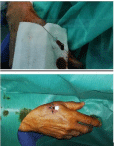
Mini Review
Austin J Anesthesia and Analgesia. 2020; 8(1): 1083.
Catheterization of Superficial Radial Artery in Operating Room
Najout H*, Azzouzi A, Bouya MS, Bouti A, Belghiti A, Grine A, Jaafari A and Bensghir M
Departement of Anesthesiology and Critical Care, Mohamed V Military Training Hospital, Faculty of Medecine and Pharmacy, Mohamed V University, Rabat, Morocco
*Corresponding author: Hamza Najout, Departement of Anesthesiology and Critical Care, Mohamed V Military Training Hospital, Faculty of Medecine and Pharmacy, Mohamed V University, Rabat, Morocco
Received: January 11, 2020; Accepted: February 12, 2020; Published: February 19, 2020
Abstract
The approach of the radial artery at its distal surface is an attractive alternative to conventional technique. We describe its anatomical landmarks, its benefits and its limits.
Keywords: Distal radial artery; Catheterization; Critical care; Operating room
Introduction
Invasive monitoring of blood pressure is justified in the operating room as well as in intensive care unit. It allows accurate, reliable and momentary measurement of blood pressure. It also facilitates the taking of iterative blood samples.
Radial and femoral approach are the most used sites. Incidentally, the axillary and pedal pathway are an alternative in case of difficulty access or in arterial diseases of upper or lower limbs.
Recently a new approach has been described through the superficial distal radial artery. This technique, developed mainly by cardiologists in the field of coronarography and angioplasty, can be proposed for patients in the intensive care unit and during surgical procedures.
Technique, Advantages and Limits
The superficial distal radial artery is palpable at the junction of the intersection of the thumb and the index at the level of the snuffbox. The hand is placed in supination and the thumb in flexion [1] (Figure 1).

Figure 1: Catheter insertion.
The needle must be inserted at an angle of 30° to 45°. Puncture involves the anterior wall of the artery and the guide is then gently introduced.
The distal radial path is more comfortable for the patient. It provides a right (not crooked) arterial axis. The occlusion rate of the radial artery at the distal puncture point is lower compared to traditional techniques and the anterograde blood flow is preserved through the superficial palmar arch, thus minimizing the risk of hand ischemia, thrombosis and extensive occlusion of the radial artery to the forearm [2].
On the other hand, this technique requires a learning curve. It is also not recommended for large catheters (greater than 6F) because the diameter of the radial artery is lower at this level.
Conclusion
Catheterization of the superficial distal radial artery represents an alternative to conventional techniques. Its main advantage lies in its simplicity and a low rate of complications, in particular thrombotic.
More studies are needed to confirm these data.
References
- Bouzerda A, Kaddaf S, Lakhal Z, Bendriss L, Khatouri A. Artère radiale distale: Nouvelle voie d’abord en cardiologie interventionelle. Journal Marocain des Sciences Médicales: 2017.
- Kiemeneij F. Left distal transradial access in the anatomical snuffbox for coronary angiography and interventions. EuroIntervention 2017; 20: 851-857.